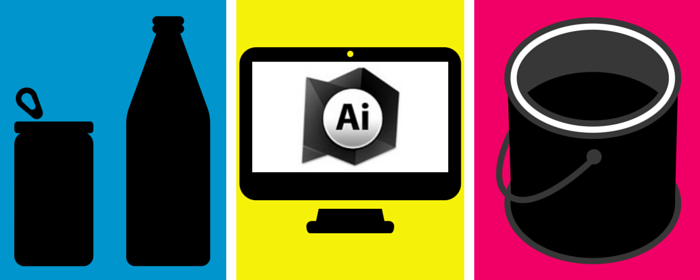
There’s a lot of information out there about what SHOULD be done when getting custom labels produced, but just as important is the list of things you SHOULDN’T do! Depending on your familiarity with custom label printing, some of these tips may surprise you. Check out these top no-no’s and see how easy it can be to avoid these common missteps.
Mistake 1: “I don’t have a container yet.”
Designing a label before you’ve chosen a container is kind of like getting a custom suit made without giving your tailor any measurements. It’s important that you give us the container’s measurements (or send us a sample container so we can measure it) so you don’t end up with labels that don’t fit. Depending on the container’s shape and size, you will probably have several cutting die options to choose from. Labels that are too large or small can affect your packaging’s look and possibly cost you money if new labels need to be printed. If you don’t know how to measure a container, check out our informational video to learn how.
Mistake 2: “Any label will work with the container.”
There are benefits and drawbacks to any container you choose. Round bottles are easy to work with since pretty much any label shape can be applied to it. However, there are many types of products packaged in round bottles, which means your product may not stand out. A unique container is more likely to catch your customer’s eye but it also can be more challenging to find the right label size and shape if the container has contours. That’s where having an extensive library of cutting dies like ours comes in handy. We can create labels in many shapes and sizes; we just need to the type of container you have and its dimensions to ensure a good fit.
Mistake 3: “I don’t need my artwork professionally designed.”
It may be hard to believe, but getting your artwork professionally designed can save you time and money in the long run. If you have a simple design, then doing it yourself might make sense (just keep in mind to design in CMYK – not RGB!). But for something more elaborate, hire a professional because he or she will be able to design artwork suitable for high-quality printing. That’s important because your order will likely be delayed by having artwork redesigned if it won’t print right, or worse, you’ll end up spending far more money than you intended because the labels will need to be reprinted.
Mistake 4: “Just give me the cheapest label material.”
One of the benefits of getting custom labels is the variety of choices you have – especially when it comes to label stocks. Selecting the cheapest material isn’t always the best way to go, not only from a performance standpoint but an aesthetic one as well. The right label stock can transform packaging, enhance label artwork and make a brand more memorable. Foil, holographic, clear and matte materials are popular options since they’re eye-catching and work with different container types. Although these materials are more expensive, they will help to differentiate your product on store shelves.
Mistake 5: “Any adhesive will do.”
There are hundreds of adhesives available that fall under three classifications: permanent, removable and repositionable. If you need your labels to stick through a variety of conditions, a permanent adhesive would be a good choice. However, permanent adhesives make it hard to reapply a label once it’s on a surface which creates a problem if the label wasn’t applied straight. In this case, a repositionable adhesive is better since it won’t leave behind label bits on the container. Label buyers often don’t realize there are a lot of things to consider. For example, a permanent label isn’t guaranteed to stick to every surface because certain surfaces (e.g. tires, wood, etc.) can be very challenging to label. Let your service rep know as much as you can about how your labels are going to be applied and where they’ll be used so they can help you pick the right adhesive.
Mistake 6: “The finish isn’t important.”
Choosing the right finish for your custom labels is essential because it can not only help protect the label, but also add visual interest to the design. Depending on the level of label protection you need, or have a special design effect in mind, we have different types of finishes that will help achieve your goal. Again, communication is key here and the more your label company knows about the environments your product will encounter, the easier it will be to determine options that can work. You may not need a finish if your labels are for short-term, disposable use; but if they need to withstand moisture and abrasion, then a laminate finish would be necessary. With a partial UV coating, custom labels can be both matte and glossy which creates a unique look. Tell us what your labels need to accomplish over their lifespan so we’ll be able to know which finish will work best.
Avoiding these common mistakes, even a couple of them, can improve your label experience and product quality. Communicating the details of your project will help ensure that your custom labels are printed right, on-time and with minimal hassle. Now that you’re familiar with some common issues that label buyers face, check out our “Best Practices of Designing Custom Labels” article to learn how to prepare your design for high quality printing.


